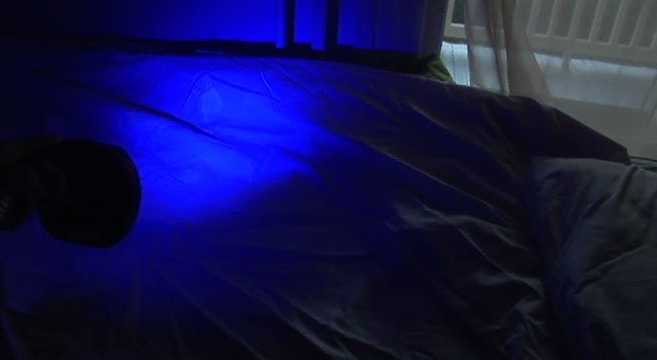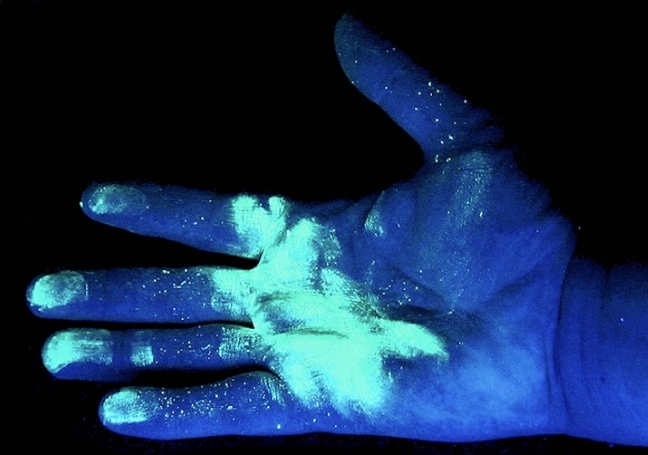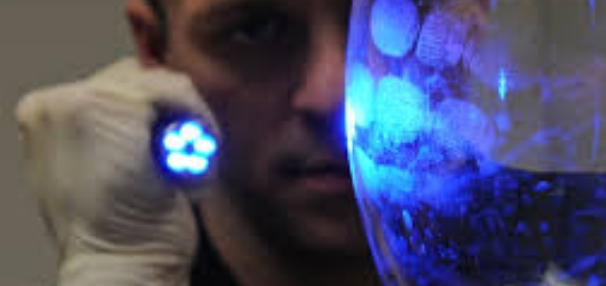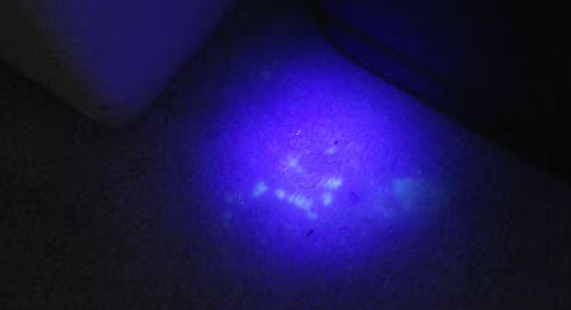The post How UV Light Reveals Hidden Evidence at Crime Scenes appeared first on Tank007.
]]>1. The Science Behind UV Light in Forensics
UV light is a type of electromagnetic radiation with wavelengths shorter than visible light but longer than X-rays. In forensics, two main types of UV light are commonly used:
- UV-A (Longwave): 320–400 nm, less intense, often used for general searches.
- UV-C (Shortwave): 100–280 nm, more intense, effective for revealing specific substances.
How UV Light Works: When UV light shines on certain substances, they absorb the energy and re-emit it as visible light—a process known as fluorescence. Many biological materials and synthetic substances fluoresce under UV light, making them easier to detect.
2. Common Types of Evidence Revealed by UV Light
| Type of Evidence | UV Wavelength Used | Fluorescence Color | Common Applications |
|---|---|---|---|
| Bodily Fluids (e.g., blood, saliva, semen) | UV-A (365 nm) | Blue, green, or yellow | Sexual assault cases, violent crimes |
| Fingerprints (with fluorescent powder) | UV-A (365–395 nm) | Bright blue or green | Burglary, theft |
| Fibers and Textiles | UV-C (254 nm) | Various colors | Linking suspects to crime scenes |
| Bone Fragments | UV-C (254 nm) | Pale white or green | Mass graves, cold cases |
| Drugs and Narcotics | UV-A (365 nm) | Blue or green | Drug enforcement |
Insight: Choosing the correct UV wavelength is essential for maximizing evidence detection.
3. How UV Light Detects Bodily Fluids

Bodily fluids like semen, saliva, and sweat contain compounds that fluoresce under UV-A light due to proteins and enzymes. However, blood does not fluoresce naturally; it absorbs UV light instead, appearing black or dark.
Method:
- Investigators darken the room and use a UV-A flashlight.
- Protective goggles are worn to enhance visibility of the fluorescence.
- Fluids emit blue, green, or yellow fluorescence, helping identify their locations.
4. Using UV Light for Fingerprint Detection
Fingerprints are made visible under UV light when treated with fluorescent powders or dyes such as Rhodamine 6G or Ninhydrin. The oils and sweat in prints can also fluoresce directly.
| Detection Method | Advantages | Disadvantages |
|---|---|---|
| Fluorescent Powder + UV-A | Clear visibility, effective on non-porous surfaces | Requires careful application |
| Ninhydrin + UV-A | Useful on porous surfaces (e.g., paper) | Time-consuming to develop |
| Direct UV Light (No Powder) | Quick and easy | Lower contrast, limited to fresh prints |
Recommendation: Using fluorescent powder and UV-A light offers the best results for non-porous surfaces.
5. Comparing UV Wavelengths for Forensic Applications
| UV Wavelength | Common Uses | Advantages | Disadvantages |
|---|---|---|---|
| UV-A (Longwave, 365–395 nm) | Bodily fluids, fingerprints, narcotics | Less damaging to evidence, portable | Lower fluorescence intensity |
| UV-B (Midwave, 280–320 nm) | Rarely used in forensics | Moderate fluorescence | Potential skin damage to investigators |
| UV-C (Shortwave, 100–280 nm) | Fibers, bone fragments, aged blood | High fluorescence, effective for trace evidence | More dangerous, requires protective gear |
Key Insight: For safety and effectiveness, UV-A light is the most commonly used in field investigations.
6. Case Studies: UV Light Solving Crimes

Case Study 1: The Hotel Room Assault
- Situation: A suspected assault in a hotel room.
- Method: Investigators used a 365 nm UV-A flashlight.
- Findings: Detected semen stains on bedsheets that were invisible under normal light.
- Outcome: Provided critical DNA evidence that led to a conviction.
Case Study 2: Drug Trafficking Bust
- Situation: Narcotics hidden in a car dashboard.
- Method: UV-A light used to detect traces of fluorescent-tagged drugs.
- Findings: Confirmed the presence of cocaine residues.
- Outcome: Helped secure charges against suspects.
Conclusion: These cases highlight the practicality and reliability of UV light in uncovering hidden evidence.
7. Challenges and Limitations of UV Light in Forensics
| Challenge | Impact | Solution |
|---|---|---|
| Background Fluorescence | False positives due to materials like detergents | Use contrast filters and multiple wavelengths |
| Degraded Evidence | Reduced fluorescence in aged samples | Enhance using chemicals like luminol |
| Health Risks | UV-C can cause skin and eye damage | Wear protective glasses and clothing |
Recommendation: Proper training and equipment are essential for safe and accurate UV light use.
8. Maintenance Tips for UV Flashlights in Forensics
- Regular Cleaning: Use alcohol wipes to remove residue from the lens.
- Battery Check: Ensure full charge to maintain optimal brightness.
- Wavelength Calibration: Verify with a spectrometer if available.
Tip: Store UV flashlights in protective cases to avoid lens scratches.
9. Summary of Key Findings
| Aspect | Key Insight |
|---|---|
| Best Wavelength for Forensics | UV-A (365 nm) for most biological and trace evidence |
| Most Common Evidence Detected | Bodily fluids, fingerprints, fibers |
| Top Challenges | Background fluorescence, safety risks |
| Recommended Practice | Use protective gear and combine wavelengths |
Conclusion: UV light is an essential tool for forensic investigations, capable of revealing hidden evidence quickly and efficiently. By understanding the science and limitations of UV light, investigators can maximize its potential in solving crimes.
The post How UV Light Reveals Hidden Evidence at Crime Scenes appeared first on Tank007.
]]>The post The Role of UV Flashlights in Crime Scene Investigation appeared first on Tank007.
]]>In modern crime scene investigations, ultraviolet (UV) flashlights have become essential tools for forensic experts. They are used to detect, analyze, and document evidence that is invisible to the naked eye. UV light can reveal bodily fluids, fingerprints, drug residues, and trace evidence, significantly improving the efficiency and accuracy of investigations. This article explores the science behind UV flashlights, their practical applications, and key considerations when using them in forensic work.
1. The Science Behind UV Flashlights in Forensics

UV light is a type of electromagnetic radiation with wavelengths shorter than visible light but longer than X-rays. For forensic purposes, UV flashlights typically operate within three main UV spectrums:
| UV Spectrum | Wavelength Range | Application in Forensics |
|---|---|---|
| UV-A (Longwave) | 320–400 nm | Detection of bodily fluids, trace evidence, and counterfeit materials. |
| UV-B (Midwave) | 280–320 nm | Limited forensic use; can reveal specific chemical traces. |
| UV-C (Shortwave) | 100–280 nm | Sterilization and detection of certain biological evidence. |
Fluorescence Effect: When UV light strikes certain materials, they absorb the energy and re-emit it as visible light, causing them to fluoresce. This phenomenon allows investigators to identify hidden evidence.
2. Key Applications of UV Flashlights in Crime Scene Investigation
UV flashlights are utilized across various forensic disciplines. Below are some critical applications:
| Application | Description | Evidence Detected |
|---|---|---|
| Bodily Fluids Detection | UV light reveals blood, semen, saliva, and other fluids due to fluorescence. | Bloodstains, saliva, semen, urine. |
| Fingerprint Analysis | Enhances fingerprint visibility after treatment with fluorescent dyes. | Fingerprints on non-porous surfaces. |
| Drug Residue Identification | Certain drugs fluoresce under UV light. | Cocaine, heroin, amphetamines. |
| Trace Evidence Detection | Identifies fibers, hairs, and other small evidence. | Textile fibers, hair strands. |
| Document Examination | Reveals alterations, forgeries, and counterfeit currency. | Altered documents, fake currency. |
3. Step-by-Step Guide to Using UV Flashlights at Crime Scenes

Effective use of UV flashlights requires a systematic approach.
| Step | Action | Objective |
|---|---|---|
| 1 | Secure the crime scene. | Prevent contamination of evidence. |
| 2 | Darken the area. | Maximize visibility of fluorescent evidence. |
| 3 | Wear UV protective gear. | Protect eyes and skin from UV exposure. |
| 4 | Scan surfaces with UV light. | Identify areas of interest. |
| 5 | Mark and document evidence. | Record findings accurately. |
| 6 | Collect samples carefully. | Preserve integrity of evidence. |
| 7 | Analyze in the lab under controlled conditions. | Confirm initial findings. |
Best Practice Tip: Use UV light at different angles and distances to ensure no evidence is missed.
4. Advantages and Limitations of UV Flashlights in Forensics
While UV flashlights are highly effective, they also come with limitations:
| Aspect | Advantages | Limitations |
|---|---|---|
| Detection Ability | Can reveal evidence invisible to the naked eye. | Some materials may not fluoresce clearly. |
| Portability | Compact and easy to carry. | Requires specific power sources. |
| Non-Destructive | Does not damage evidence. | Prolonged exposure can degrade certain materials. |
| Cost-Effective | Affordable compared to other forensic tools. | Requires training for optimal use. |
| Environmental Dependence | Effective in dark environments. | Bright ambient light reduces visibility. |
5. Real-World Case Study: UV Flashlights in Action

Case Study: The Identification of a Hidden Bloodstain
- Scenario: Investigators discovered a crime scene where blood traces had been cleaned thoroughly.
- Solution: Using a UV flashlight, experts identified residual bloodstains on the floor and walls.
- Outcome: DNA analysis confirmed the identity of the suspect, leading to a conviction.
Key Takeaway: UV flashlights are invaluable for detecting concealed evidence, even in situations where suspects attempt to clean or hide traces.
6. Choosing the Right UV Flashlight for Forensic Use
Selecting the right UV flashlight is crucial for effective evidence detection.
| Feature | Recommendation | Reason |
|---|---|---|
| Wavelength | 365 nm | Ideal for detecting most bodily fluids and trace evidence. |
| Light Intensity | High output (e.g., 1000mW) | Ensures effective fluorescence. |
| Battery Life | Long-lasting | Reduces interruptions during investigations. |
| Build Quality | Waterproof and durable | Suitable for harsh crime scene environments. |
| Portability | Lightweight design | Easy to handle during prolonged use. |
7. Safety Precautions When Using UV Flashlights
UV light can be harmful if not used properly. Follow these safety guidelines:
- Wear UV-blocking glasses and gloves.
- Avoid direct exposure of UV light to skin and eyes.
- Use UV flashlights in short bursts to minimize exposure.
- Train investigators in proper handling and usage.
- Store UV flashlights safely when not in use.
8. Conclusion
UV flashlights have revolutionized the field of crime scene investigation by providing a reliable, non-destructive method to uncover hidden evidence. Their ability to detect bodily fluids, fingerprints, and trace materials makes them an indispensable tool for forensic professionals. However, effective use requires proper training, appropriate equipment selection, and strict adherence to safety protocols.

By incorporating UV flashlight technology into standard forensic practices, investigators can significantly improve the accuracy and reliability of evidence collection, ultimately leading to more successful criminal convictions.
The post The Role of UV Flashlights in Crime Scene Investigation appeared first on Tank007.
]]>The post Applications of UV flashlights in criminal investigation and forensics, such as finding hidden bloodstains, fingerprints and other evidence appeared first on Tank007.
]]>
- Bloodstain detection: Blood emits fluorescence under ultraviolet light, making uv flashlights a powerful tool for detecting concealed or cleaned-up bloodstains. These bloodstains may be deliberately obscured by criminals or may be difficult to detect under normal lighting.
- Fluid detection: Apart from blood, other bodily fluids like semen, saliva, and urine also fluoresce under ultraviolet light. These pieces of evidence can help investigators track suspects or confirm different crime details.
- Fingerprint identification: Fingerprints may not be visible under regular lighting in certain circumstances, but they exhibit visible fluorescence under ultraviolet light. UV flashlights can reveal hidden fingerprints, which is invaluable in solving cases like burglaries.
- Tracing transferred items: Criminals often attempt to transfer items to other locations after committing the crime to cover their tracks. Ultraviolet flashlights can help locate these items, as they may retain fluorescence marks from the crime scene.
- Evidence detection: Critical evidence such as hair, fibers, fluorescent dust, etc., may be present at the crime scene or on the victim. Under ultraviolet light, such evidence becomes more discernible.
- Crime scene investigation: Ultraviolet flashlights are useful for conducting crime scene investigations, aiding in determining the area of the incident, searching for discarded items, or finding evidence.

It is important to note that while ultraviolet flashlights have significant applications in criminal investigations and forensic science, they are merely auxiliary tools and need to be used in conjunction with other investigation techniques and methods. Additionally, when using ultraviolet flashlights, investigators should take appropriate protective measures, as prolonged exposure to ultraviolet light can be harmful to the eyes and skin.
The post Applications of UV flashlights in criminal investigation and forensics, such as finding hidden bloodstains, fingerprints and other evidence appeared first on Tank007.
]]>